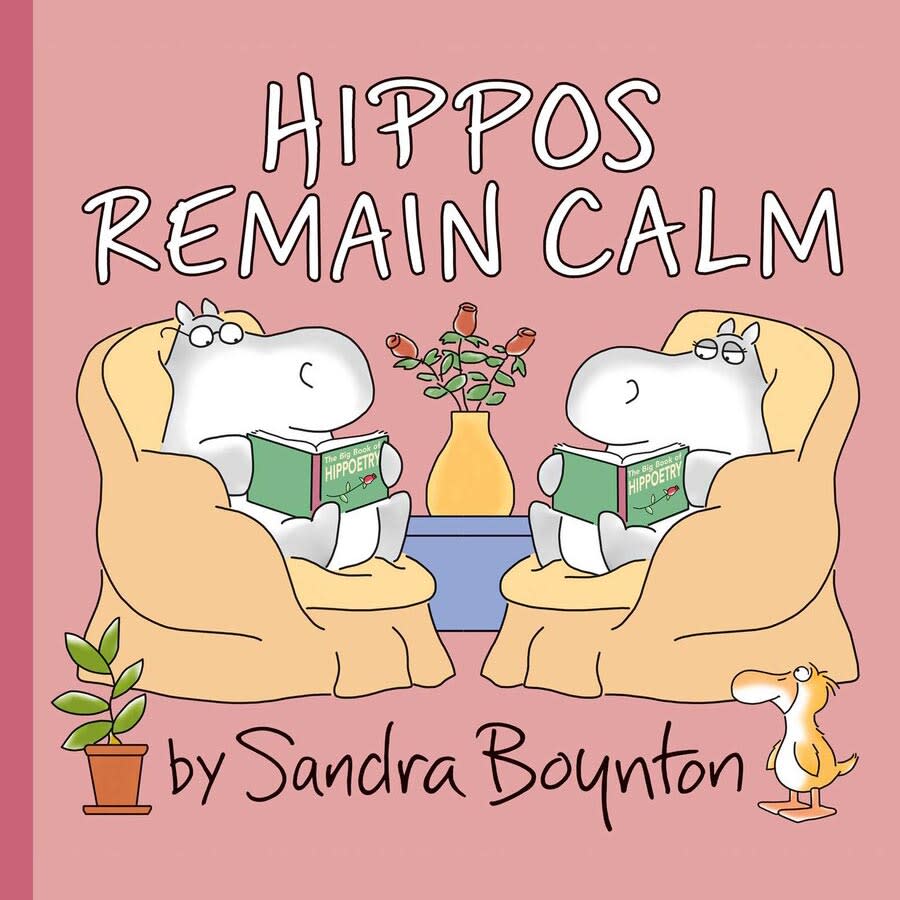One of the Greatest Children’s Books of All Time Just Got a Sequel. The Author Has Her Reasons.
- Oops!Something went wrong.Please try again later.
In 1977 the 24-year-old greeting card artist Sandra Boynton published her first book, Hippos Go Berserk! A “wild counting story” about a hippo whose home is visited by first two hippos, then three, then four, until 45 hippos are partying hearty all the night long, the book was the start of a prolific career in children’s literature, music, and theater. Boynton’s simply drawn sheep, chickens, cows, ducks, and monsters have entertained children, and their parents, for nearly 50 years, but the hippos have always been at the heart of her work. Thanks to many, many bedtimes, I have warm feelings for those hippos, and now that Boynton is revisiting the berserk all-night party in a new book, Hippos Remain Calm, I took the occasion to email with her. We discussed remaining calm in these troubling times, the mysteries of hippopotami, and the connection a parent makes to a beloved story. Our conversation has been edited and condensed for clarity.
Dan Kois: In Hippos Go Berserk!, a group of 44 hippos is invited over for a wild house party. Why are hippos so eager to get together and socialize?
Sandra Boynton: A close reading suggests that, aside from the first two to arrive, they haven’t necessarily been invited.
Interesting! So maybe the other hippos catch the first hippo by surprise.
If you follow the host hippo carefully, you’ll find only a few instances of apparent delight. Perplexity seems the default there.
Why do you think the hippos enjoy gathering and partying so much?
Hmmm. I imagine that each hippo has a different motivation, and each has a different experience. Not to mention that even within any given hippo, mood and perspective are ever-shifting.
Sure, but they all go berserk! Why?
I don’t really have a theory, I just report on what happened. The ways of fictive 2D bipedal hippos are notoriously mysterious. I think it’s a risky—and probably even misguided—business to think of any group as a collection of identical individuals. Well, OK, with the possible exception of mosquitoes; in my experience, they seem unnervingly similar to each other, aside from the luxuriant eyelashes on the lucky few. But that’s a different story altogether.
Are the hippos in this story truly individuated to you, the author? Do you give all 45 hippos names? Do they all have unique backstories?
I didn’t give them names, that never occurred to me. But they are individuated.
The book makes it clear that nine of the hippos at the party are catering staff. Do they too go berserk? Or are they just there to work?
According to the title, yes, they too go berserk. (The short-form narrative admittedly has its drawbacks. In the novel version, each of the nine has an entire chapter devoted to that character’s inner monologue. It’s riveting.)
Your new book, Hippos Remain Calm, retells the story of the original from a different perspective. What made you want to revisit these particular hippos?
My own cheerfully subversive nature, I suppose.

I thought maybe you heard from parents that their kids needed to see some calm hippos, rather than hippos going berserk.

Not at all! It was my own observation of grown people all around me these strange days that urged the book.
Are more people in your life trying—and perhaps failing—to remain calm nowadays?
Yes! It’s not subtle, and it surely includes me. And it’s certainly understandable.
These two hippos have a number of tactics for remaining calm. They meditate. They take long walks. Are these also your methods for remaining calm?
I grew up Quaker, and went to a wonderful Quaker school (where my father was a terrific English teacher) for 12 years, so finding stillness and encountering each person as an individual is pretty much baked in. And music and writing and art and critical thinking were also central to that education—which is the luckiest thing imaginable for a growing person. In consequence, I also find calm by drawing hippos and writing music and giving impertinent answers and stuff.
You do seem to enjoy giving puckish answers to questions. Do you think it is silly to interrogate a children’s book about fictive 2D hippos too closely? As a parent who has read Hippos Go Berserk! about 4,000 times, I find that I end up giving an enormous amount of thought to the board books that have been staples in our family, probably more thought than I have given to any other works of art.
I don’t think it’s silly at all! I very much appreciate your questions, and your interest; my answers are sincere. Heck, the New York Times (board books are oddly not eligible for the NYT bestseller list) and Literary Hub (“The Toddler Book Tolerability Index” is a recent article) don’t seem to imagine that board books could be literature at all—as if very young children are not conscious beings, as if language and visual narrative don’t really count in the first two or three years of life, as if repetition is a chore for the parent. It’s a staggering shortfall. You yourself have read books so many times aloud to your child, yet you see it as a pleasure and not a slog.
Would you like to attend a hippo party?
THEY NEVER INVITE ME! What’s up with that?
Would you say you are a calm person or a berserk person?
Both. Simultaneously.

